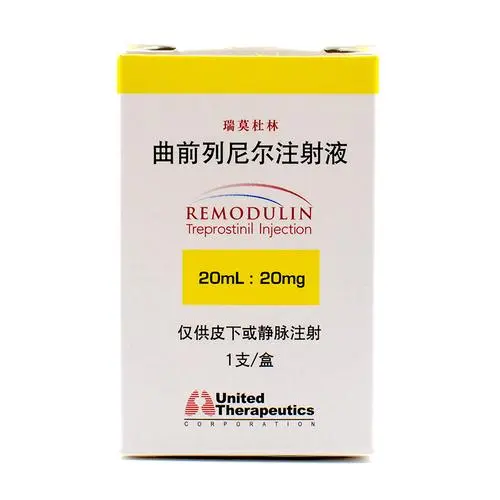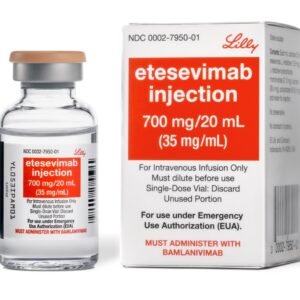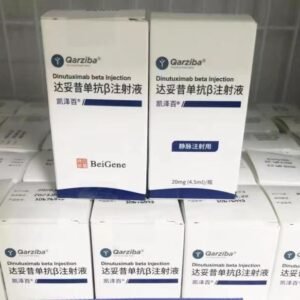Treprostinil
Functional Indications:
Indicated for the treatment of pulmonary arterial hypertension (PAH, WHO classification 1) to relieve exercise-related symptoms. Studies to establish the efficacy of this product included patients with primary and hereditary pulmonary hypertension in NYHA functional class II-IV (58%), pulmonary hypertension associated with congenital systemic pulmonary shunt (23%), and Pulmonary hypertension associated with connective tissue disease (19%).
Dosage:
This product is packaged in 20ml glass bottles and comes in four specifications, containing 20, 50, 100 or 200mg treprostinil (1mg/ml, 2.5mg/ml, 5mg/ml or 10mg/ml). This product needs to be diluted with water for injection or 0.9% NaCl injection before infusion. This product is administered subcutaneously or intravenously. 1. Initial dosage for patients receiving prostacyclin infusion for the first time: This product can only be infused continuously subcutaneously (SC) or intravenously (IV). Subcutaneous infusion is the preferred route of administration, however, if subcutaneous administration is not tolerated because of severe pain or reaction at the infusion site, administration via a central venous catheter may also be used. The initial infusion rate is 1.25ng/kg/min. If the initial dose cannot be tolerated due to systemic effects, the injection rate should be reduced to 0.625 ng/kg/min. 2. Dosage adjustment: (1) The goal of long-term dose adjustment is to determine the dose of treprostinil so that it can improve the symptoms of pulmonary hypertension while reducing other pharmacological effects of this product (headache, nausea, vomiting, restlessness, anxiety and Infusion site pain or reaction). (2) Adjust dosage according to clinical efficacy. The infusion rate increases to 1.25 ng/kg/min per week during the first four weeks of treatment and 2.5 ng/kg/min per week thereafter. Dose may be adjusted more frequently if tolerated. There is very little clinical experience with doses >40ng/kg/min. Abrupt cessation of the infusion should be avoided. Administration may be resumed at the same dose rate within a few hours of interruption, and dose re-titration may be necessary if the interruption is longer. (3) Patients with hepatic insufficiency: For patients with mild to moderate hepatic insufficiency, the initial dose of this product should be 0.625ng/kg/min, and the dosage should be calculated based on the ideal body weight. The dosage must be increased with caution. It has not been studied in patients with severe hepatic impairment. (4) Patients with renal insufficiency: No studies have been conducted on patients with renal insufficiency. 3. Medication method: Before injection administration, the medicine should be visually inspected for the presence of particulate matter and discoloration. Do not use this product if there are particles or discoloration. (1) Subcutaneous infusion: This product uses an infusion pump dedicated for subcutaneous drugs and is administered by continuous subcutaneous infusion through an inserted subcutaneous catheter. To avoid interruption of drug infusion, a backup infusion pump and subcutaneous infusion set must be immediately available to the patient should this occur. The mobile infusion pump used for administering this product should meet the following requirements: ① Small size and light weight. ②The minimum infusion speed adjustable limit is approximately 0.002ml/h. ③Alarm reminders should be provided when the infusion tube is blocked/not infused, the equipment battery is low, the program is wrong, or the motor fails. ④The infusion speed accuracy is ±6% or better. ⑤ Positive pressure drive. Reservoirs should be made of polyvinyl chloride, polypropylene or glass. Calculate the subcutaneous infusion rate (ml/h) based on patient dose (ng/kg/min), body weight (kg), and drug strength (mg/ml) without further dilution. During use, the liquid reservoir (syringe) containing the undiluted product can be administered for up to 72 hours at 37°C. (2) Intravenous infusion: This product must be diluted with sterile water for injection or 0.9% sodium chloride injection, and then administered by continuous intravenous infusion through an indwelling central venous catheter using an infusion pump dedicated for intravenous drug delivery. If clinically necessary, a temporary peripheral intravenous cannula can be placed in a large vein for short-term administration of this product. Peripheral intravenous infusion for several hours may increase the risk of thrombophlebitis. To avoid interruption of drug infusion, a backup infusion pump and subcutaneous infusion set must be immediately available to the patient should this occur. The mobile infusion pump used for administering this product should meet the following requirements: ① Small size and light weight. ②Alarm reminders should be provided when the infusion tube is blocked/no infusion, equipment battery is low, program error or motor failure occurs. ③The infusion speed accuracy is ±6% or better. ④ Positive pressure drive. Reservoirs should be made of polyvinyl chloride, polypropylene or glass. This product can be stored stably at room temperature for 48 hours when diluted to a concentration as low as 0.004mg/ml (4000ng/ml). When using an appropriate infusion pump and reservoir, the intravenous infusion rate should first be selected based on the ideal infusion period of 48 hours between system changes. Typical intravenous infusion reservoirs are 50ml or 100ml. Please refer to the instruction manual for relevant calculation formulas.
Adverse reactions:
1. Clinical trial experience: (1) Adverse events of subcutaneous administration: ① A variety of adverse events occur after subcutaneous administration of this product, most of which may be related to underlying diseases (dyspnea, fatigue, chest pain, right heart failure, and pale).
Share:
Products
Our offers
Health Classification
Let us work together to protect precious health






























